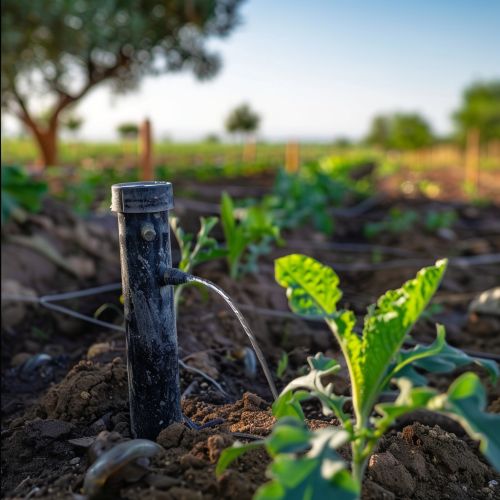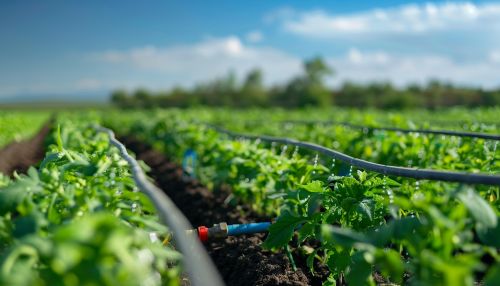Fertigation: Difference between revisions
(Created page with "== Introduction == Fertigation is an agricultural technique that involves the application of fertilizers, soil amendments, or other water-soluble products through an irrigation system. This method allows for precise control over the timing and quantity of nutrient delivery to crops, leading to improved efficiency and potentially higher yields. Fertigation is commonly used in both open-field and greenhouse agriculture and is particularly beneficial in areas with limited...") |
No edit summary |
||
| Line 21: | Line 21: | ||
Drip fertigation is one of the most efficient methods, as it delivers water and nutrients directly to the plant root zone with minimal waste. This system is particularly effective in arid regions where water conservation is critical. | Drip fertigation is one of the most efficient methods, as it delivers water and nutrients directly to the plant root zone with minimal waste. This system is particularly effective in arid regions where water conservation is critical. | ||
[[Image:Detail-92277.jpg|thumb|center|Close-up of a drip irrigation system in a field of crops.|class=only_on_mobile]] | |||
[[Image:Detail-92278.jpg|thumb|center|Close-up of a drip irrigation system in a field of crops.|class=only_on_desktop]] | |||
=== Sprinkler Fertigation === | === Sprinkler Fertigation === | ||
Latest revision as of 07:56, 15 June 2024
Introduction
Fertigation is an agricultural technique that involves the application of fertilizers, soil amendments, or other water-soluble products through an irrigation system. This method allows for precise control over the timing and quantity of nutrient delivery to crops, leading to improved efficiency and potentially higher yields. Fertigation is commonly used in both open-field and greenhouse agriculture and is particularly beneficial in areas with limited water resources.
History and Development
The concept of fertigation has evolved significantly since its inception. Early forms of fertigation can be traced back to the 19th century when farmers began experimenting with the addition of soluble fertilizers to irrigation water. However, it wasn't until the mid-20th century, with advancements in irrigation technology and the development of more soluble fertilizers, that fertigation became a widely adopted practice.
Principles of Fertigation
Fertigation operates on the principle of delivering nutrients directly to the plant root zone through the irrigation system. This method ensures that nutrients are readily available for uptake by the plants, reducing losses due to leaching or volatilization. The key components of a fertigation system include:
- **Irrigation System:** This can be a drip irrigation system, sprinkler system, or any other method that delivers water directly to the plants.
- **Fertilizer Injector:** A device that injects the fertilizer solution into the irrigation water.
- **Fertilizer Solution:** A mixture of water and soluble fertilizers tailored to the specific needs of the crop.
Types of Fertigation Systems
Drip Fertigation
Drip fertigation is one of the most efficient methods, as it delivers water and nutrients directly to the plant root zone with minimal waste. This system is particularly effective in arid regions where water conservation is critical.


Sprinkler Fertigation
Sprinkler fertigation involves the use of overhead sprinklers to distribute water and nutrients. While less efficient than drip systems, it is suitable for crops that require overhead watering.
Subsurface Fertigation
Subsurface fertigation delivers nutrients below the soil surface, directly to the root zone. This method minimizes evaporation and runoff, making it highly efficient.
Advantages of Fertigation
Fertigation offers several advantages over traditional fertilization methods:
- **Precision:** Nutrients are delivered in precise amounts, reducing waste and environmental impact.
- **Efficiency:** Nutrients are available to plants immediately, improving uptake and reducing losses.
- **Flexibility:** Fertigation schedules can be easily adjusted to meet the changing needs of crops.
- **Water Conservation:** By combining irrigation and fertilization, fertigation can reduce water usage.
Challenges and Limitations
Despite its advantages, fertigation also presents several challenges:
- **Initial Cost:** The setup of a fertigation system can be expensive, requiring investment in specialized equipment.
- **Maintenance:** Regular maintenance is required to prevent clogging and ensure the system operates efficiently.
- **Technical Knowledge:** Successful fertigation requires a good understanding of both irrigation and fertilization practices.
Nutrient Management in Fertigation
Effective nutrient management is crucial for the success of fertigation. This involves selecting the right type and amount of fertilizer, as well as timing the application to match the crop's growth stages. Commonly used fertilizers in fertigation include:
- **Nitrogen Fertilizers:** Such as urea, ammonium nitrate, and calcium nitrate.
- **Phosphorus Fertilizers:** Such as monoammonium phosphate (MAP) and diammonium phosphate (DAP).
- **Potassium Fertilizers:** Such as potassium chloride and potassium sulfate.
Environmental Impact
Fertigation can have both positive and negative environmental impacts. On the positive side, it can reduce nutrient runoff and leaching, minimizing the risk of water pollution. However, improper management can lead to over-fertilization and subsequent environmental degradation.
Future Trends in Fertigation
The future of fertigation is likely to be shaped by advancements in technology and increasing emphasis on sustainable agriculture. Innovations such as automated fertigation systems, precision agriculture techniques, and the use of organic fertilizers are expected to drive the adoption of fertigation in the coming years.
